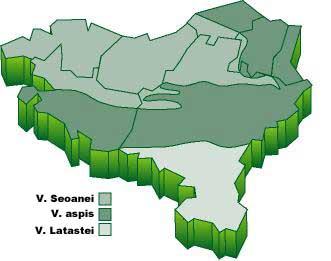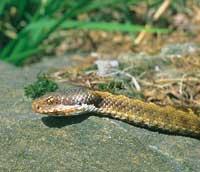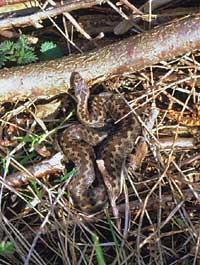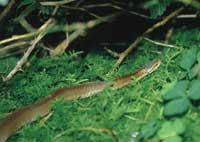Small Cantabrian viper but… powerful

Few people can be quiet when seeing the snake next door, and even less knowing that this snake is viper. And it is that, although many snakes without poison are quieter than many, the vipers are poisonous and, therefore, caution. These reptiles, by their small size, triangular head and vertical pupil, are easily separable. To check these details you have to approach and, of course, not play.
In our territory we have three species of vipers that, as it has been drawn in the distribution map, cover all the territory between the three and without overlap. Normally the Cantabrian viper ( Vipera seoanei ) appears on the Atlantic side; the viper aspis (Vipera aspis ) in the Pyrenees and centre and, finally, the viper latar (Vipera )

Its length is low, not exceeding 50 cm, but with a robust body. It has flared dorsal scales, with 21 lines in the center of the body and 128-145 in the ventral side. The coloring is very variable: above it is typically brown-reddish and has a dark footprint that makes zigzag along the back. However, very dark specimens, black or without drawing, are not rare. Belly normally dark uniform.
Although it can appear from the sea level up to 1,200 meters high, the Cantabrian viper is the most abundant among the 200-700 meters. It needs a lot of humidity and does not live in places with less than 1,200 liters of water per square meter per year. It is common in areas of meadows, heather, argomals, scrub, open forests and, in general, in places with abundant vegetation. Among the areas he likes most are the barriers, the forest edges, the slopes of the forest tracks and the walls of the constructions of the farmers.
On the other hand, he is a good rod hunter and very skilled in hunting small vertebrates. It detects the catch dancing the tongue thanks to the organ of Jacobs. This Jacobson organ on the palate fulfills a function similar to the smell and serves to analyze the chemical stimuli obtained through the tongue. To kill the hunting pieces he uses mobile fangs drilled by the viper, so that when the poison dies between directly the glands to the prey.

As for the detection technique of hunting pieces, the viper is silent in the vegetation. Although it usually moves slowly, if you approach your prey, in a ziztu throws the head forward like a dock and bites with the mouth open. It seems that it has a certain capacity to calculate enough poison to kill hunting in snake bite, to prevent such an important substance being wasted. Then, for the poison to do its job, wait quietly and then, stirring the tongue follows the footprint of hunting. As the poison influences in a short time, hunting can only make a short path, and when it finds it it devours it entirely.
This famous poison is, in short, a substance produced by modified salivary glands and consists of proteins, toxins and enzymes. Its function is, therefore, to kill the piece and facilitate digestion. However, this substance also uses it for its defense, and although it is a calm and fleeting animal, it can die if attacked. The venom of the viper is hemolytic and coagulant and produces hypotension, alteration of the heart rate, necrosis and edema. However, the venom of the Cantabrian viper of the area is weaker than that of the western specimens and that of the viper aspis of the same species and does not appear to be enough to kill a healthy adult.
From the month of November, before the hardest face of winter arrives, the cantabrian vipers are buried individually and collectively and put in a lethargy until the end of February. On the other hand, throughout the year, they are revealed twice, significantly altering their appearance. The slow colors and diffused eyes before changing the leather become discreet and soft when replenishing the leather.

Reproduce in spring and sometimes in autumn. The males are placed one in front of the other and pushing the head and neck, the strongest can flirt with the female. As an adaptation to cold climates, the vipers are ovoid, so the eggs incubate inside the mother until the time of delivery. For this reason, to accelerate the gestation of 12-17 weeks, the female is often put in the sun to be hot and does not make changes to direct all the energy to the preparation of the eggs. The 4-8 offspring are thrown into the world from July-August, and despite having only a length of 16-17 cm, they have poison and immediately begin to hunt lizard. They may have a life of about 9 years, but few specimens reach that age. Until 1976 the Cantabrian viper was considered as a subspecies of European viper ( Vipera berus ), but that year it was given the category of species and since then we have the Iberian endemism. Only in Galicia, Asturias, Cantabria, León, Palencia and the north of Burgos, and in Euskal Herria worldwide. In Euskal Herria is also the most abundant trade in the Atlantic side.
I wanted to finish this article you read explaining what to do and what not in case of suffering snake bite. Unfortunately, after reading them in four places, I have found four different answers (one to absorb the poison, another to make the tourniquet, another to do nothing...) and all have agreed to say that the best is not to bite carefully. Great help! However, there is a serum against the poison of this species and if we enter on time, we will complete without problems.
| Cantabrian viper Species: Vipera seoanei
BuletinaBidali zure helbide elektronikoa eta jaso asteroko buletina zure sarrera-ontzian Aldizkaria |











